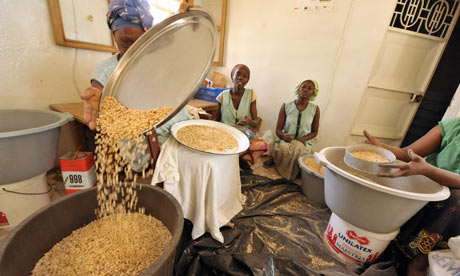
The proliferation of the western diet, which is high in refined sugars, fats, processed grains and meat, has been blamed for a rise in global obesity and diet-related illnesses such as diabetes, hypertension and heart disease. As awareness of healthy eating has grown in the west, sales of once obscure grains such as quinoa (pronounced keen-wah) have skyrocketed. The ancient 'superfood' from Peru has a fluffy texture, and is lauded for its health benefits. Unusual among grains, quinoa is packed with dietary fibre, iron, magnesium and phosphorus. It is gluten-free, easy to digest and contains all nine amino acids. Amid growing concern that unhealthy eating habits are crowding out healthier traditional crops, Food Tank: The Food Thinktank has compiled a list of indigenous fruits and vegetables that should be championed.
Amaranth
Amaranth thrives in hot climates and is typically consumed in Togo, Liberia, Guinea, Benin, and Sierra Leone. It is an excellent source of protein, vitamins and essential minerals including calcium, iron, magnesium, potassium and zinc.
Cowpea
This African legume is one of the continent's oldest crops. More commonly known as the black-eyed pea, it is drought resistant and hardy and thrives even in poor soil. All parts of the cowpea crop, including the leaves, are consumed as all are rich in nutrients and fibre.
Bitter melon
Originally from the Indian subcontinent, this sour vegetable is popular in many Asian countries, where it is sometimes called the bitter gourd or karela. This warty-looking plant thrives in tropical regions and is believed to be the world's most bitter fruit. The bitter melon has cancer-fighting properties, research shows, and has long been used as a herbal remedy for a range of ailments including type 2 diabetes.
Pamir mulberry
This fruit grows in the mountainous terrain of the Gorno-Badakhshan province of Tajikistan, which is ill-suited for the production of more common grains such as wheat and barley. The Pamir mulberry was an important food source during the second world war, and can be eaten raw, dried, whole, ground or as a jam.
Bunya nut
Bunyas are a traditional food for Australian Aboriginal people, who sometimes eat them raw or roasted or bury them in mud for months to enhance their flavour. The nuts are similar to the chestnut in appearance and taste and grow on towering, but increasingly rare, pines in the region's rainforests.
Yacón
Also known as the Peruvian ground apple, this root crop has been grown in the Andes for more than a millennium. The Yacón resembles a sweet potato on the outside, but its crunchy flesh looks more like an apple or pear. The tubers have a high water content and can be grated and squeezed through a cloth to yield a sweet, refreshing drink.
Guayabo
The green fruit, native to Uruguay and southern Brazil, has a sweet and sour taste. It has excellent nutritional and medicinal value because of its superior mineral and antioxidant content. In Uruguay, the guayabo is readily adapted to shallow soil and a mountainous environment, allowing it to thrive, even in the wild.
Perinaldo artichokes
This thistle, which has a tasty centre, is native to the Mediterranean and was cultivated in ancient Greece. Its edible flower bud is a good source of fibre, vitamin C, folic acid and minerals. This variety of artichoke is drought resistant.
Join the conversation
We want to hear from you. Have you tried these weird and wonderful vegetables? Do you have any recipe suggestions? Are there other nutritional foods that deserve a mention?
Post your comments in the thread below or add to the debate on Twitter @Gdndevelopment. If you have any problems posting, or would prefer to comment anonymously, email us at development@theguardian.com and we'll add your views to the thread.

